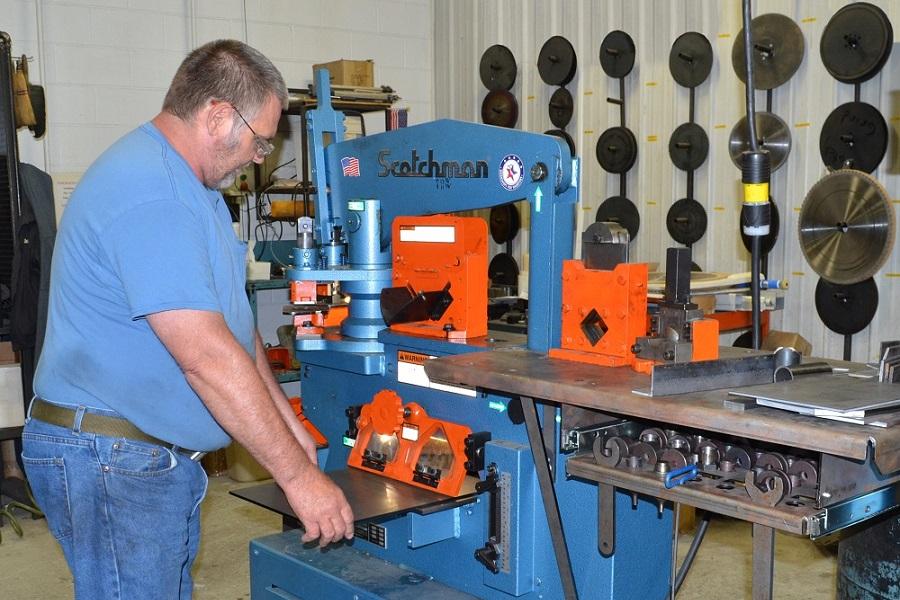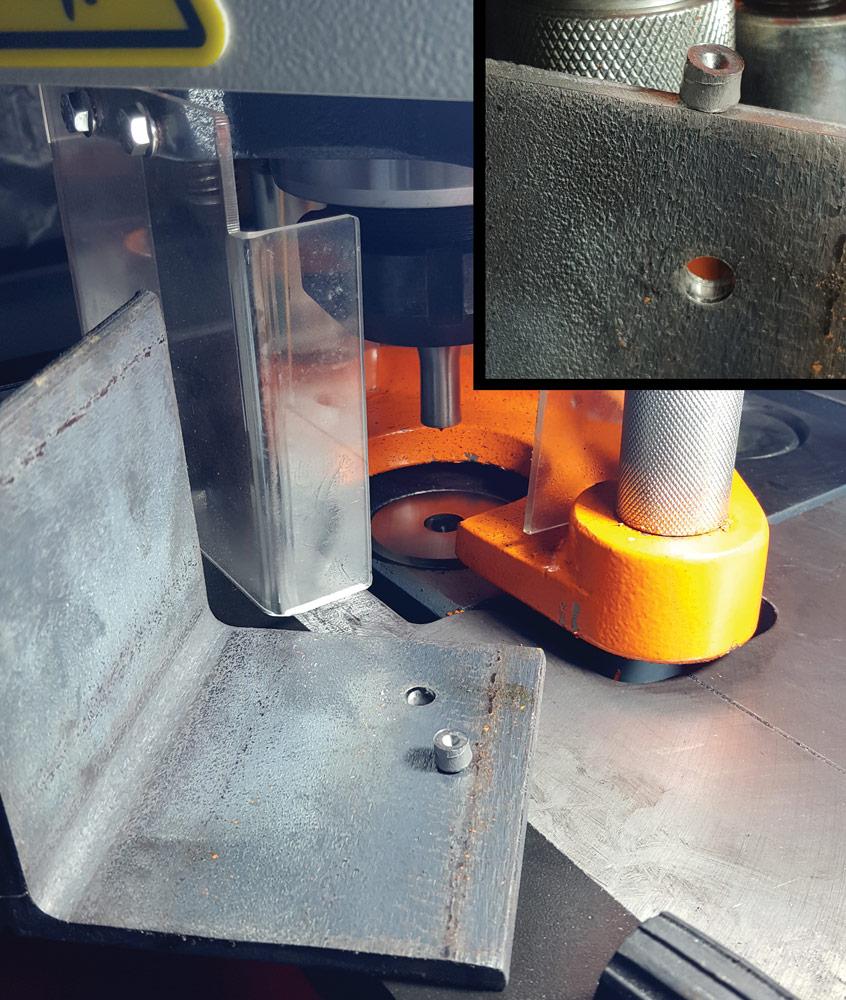Associate Editor
- FMA
- The Fabricator
- FABTECH
- Canadian Metalworking
Get the most out of your ironworker
These simple yet effective machines have various functions that make them very attractive to fabricators
- By Lindsay Luminoso
- July 8, 2021
- Article
- Fabricating

It’s important to get to know all the features of an ironworker and how they can be used in your shop. The last thing you want is to have it sitting idle because you didn’t realize it can perform a certain task you require. Scotchman
Ironworkers have been around for decades and are a staple in many fab shops. These workhorses perform a range of operations, making them extremely versatile. As shop technology advances, so too have ironworkers, and what were once primarily manual machines now have more automated features and expanded capabilities. Whether you already have a machine or are looking to purchase the latest and greatest, the experts agree that there are a few things you can do to maximize your ironworker.
Get to Know the Machine
"Ironworkers cut or bend metal," said Ebony Goldsmith, chief success facilitator, Kaast Machine Tools, Aldan, Pa. "While that may seem like a very narrow application range, a good ironworker both expands capabilities and maximizes efficiency. Typically working with square bar, angle iron, round tube, and flat stock, each of these shapes will have an infeed that can be adjusted to secure the material, providing a clean, straight cut. The outlet side can be set up with a trigger switch, allowing for quick work flow of repetitive work. Each workstation should also offer jog-mode for precise tool and workpiece positioning. Notching for weld or assembly prep can also be achieved with these Swiss army knife-type machines."
These simple yet effective machines have various functions that make them very attractive to fabricators.
"An ironworker is one of the few tools in a shop that isn’t designated for a single purpose," said Bradly Kuchenbecker, inside sales specialist, Scotchman Industries, Philip, S.D. "The way the machines are built, with so many functions available to the customer, you can buy one machine and you’re literally using it for many applications, all on one machine, which is what makes an ironworker very unique. However, it’s important to get to know the machine and all it can do for your shop. The last thing you want is to have it sitting idle because you didn’t realize it can perform a certain task you require."
For the most part, these machines have remained relatively the same over the years. In recent decades, though, the need for upgrades has increased, so ironworkers now include electronic controls, backgauges, and digital feeding systems.
"We turned the ironworker from kind of a basic bare-bones, manually operated tool closer toward a CNC machine," said Kuchenbecker. "We’re getting very close, and with all electronics and accessories accessible on a touchpad or a tablet, the operator still does have to be there to make sure the machine is functioning properly, but the degree of accuracy has increased tremendously. Understanding how hands on an operator needs to be with the machine can help fabricators adapt the work flow to meet increased demand."
Kuchenbecker added that it’s important to understand thoroughly exactly what an ironworker can do and how it functions within the shop. He gives the example of a tool cavity. Some ironworkers include a tool cavity that comes with the angle shear, which is a very popular tool. Some users are either unaware of this feature or are not sure how to use it effectively.
"The tooling cavity is either 14 or 24 in. depending on the model that you get," he said. "But within that tooling cavity, we can literally make hundreds of different tools that our customers need. Within that tool cavity you have a power source, and basically your imagination is the limit of what can be done in that area. And that feature is pretty unique to some ironworkers. Those that are not familiar with it or are unaware of the benefits may not take advantage of this extra space."
Customize Your Tooling
Whether you are punching, shearing, notching, or bending, there are different ways to customize an ironworker to make it work more efficiently.
"You should certainly think about custom dies," said Goldsmith. "They allow for more complex punching and coping and can be real time-savers."

The punch station of an ironworker tends to be one of the most used areas. One way to get more out of this station is to attach an automatic feeding system to the punch table. Kaast Machine Tools
Customized tooling and attachments, like a simple coping attachment, allow you to perform pipe coping that notches the end of pipes cleanly to fit them together for welding. This eliminates the need for secondary milling, sawing, or grinding operations. Examine your common operations and applications to see if there are ways to customize the various workstations to expand the use of the machine.
"Custom tooling can be a huge asset," said Kuchen-becker."We, for example, and I’m sure some others, have our own in-house special tooling department solely to produce and build custom tooling. Fabricators can send us a drawing or if they have an idea, we can draw it up for them. It’s a great service to take advantage of."
Incorporate the Latest Features and Accessories
The experts agree that ironworkers have advanced over the years to include more comprehensive electronics, turning these traditionally manual machines into CNC-like systems. With this advancement, adding accessories and automation can increase an ironworker’s value and capability.
The punch station of an ironworker tends to be one of the most used areas. One way to get more out of this station is to attach a feeding system to the punch table.
"This allows operators to download programs or drawings from their computer or tablet, which is hooked up to the feeding system," said Kuchenbecker. "Multiple jobs can be stored or pulled up when needed; all that’s needed is a job number. Then all the operator needs to do is load the material in the feeding system and it will advance the material step by step and punch however many holes are needed with the proper spacing. This removes the human element, providing an increased degree of accuracy and speed."
Goldsmith added that a dual-cylinder-type ironworker allows simultaneous work on the punch and a second workstation. Some punch stations allow the operator to swap in a bending station—essentially a V punch and die—for quick bends without a press brake investment.
"The latest NCs or CNCs increase productivity and accuracy while reducing scrap," said Goldsmith. "A backgauge with trigger switch also speeds repetitive-length cuts, as the cut is made as soon as the switch is triggered by the material. Stroke adjustment can also save you time, as the blades can be adjusted to open just enough for the material to be advanced, as opposed to needing to go through the entire available stroke travel."
Enroll in Training
"The tip that I would give our customers is don’t be afraid to ask questions," said Kuchenbecker. "Don’t be afraid of an automatic feeding system. They are much easier today than they were 10 to 20 years ago. Some people in our industry hear the word CNC or computer and they just automatically skip over that because they’re afraid of how complicated it may become. But the controls today are so user-friendly that the control itself will actually walk you through it. It will walk the operator through step by step how to program a part, how to download a part, and how to use the system in general. Also, especially for new customers, let factory reps and experts come in and train you and your operators properly."
When in doubt, training can be a huge asset. Proper training of operators is one of the best ways to ensure an ironworker is being used to its full potential. This is especially true when the latest accessories and technology are added. These accessories are useful only if an operator knows how to use them and takes advantage of them when needed.
Maintain the Machine
Daily, monthly, and yearly maintenance will keep an ironworker up and running.

Examine your common operations and applications to see if there are ways to adapt the various workstations with custom tooling to make better use of the machine. Scotchman Industries
"Clean your machine every day," said Goldsmith. "Ensuring schmutz, chips, and flakes are not allowed to build up in the nooks and crannies of the machine will extend its life and help it to hold accuracy. Safety goggles and an air gun are an effective, albeit messy, method; but a stiff brush and a strong wrist can have similar results. Keeping your blades clean and rust-free is also very important. You may need to apply a rust inhibitor if working in a damp or humid environment."
Beyond the simple day-to-day tasks that keep the machine clean and in good working order, proper tool setup is also important.
"The biggest mistake is rushing through your tooling setup," said Kuchenbecker. "The tooling setup process is very simple, and it has only a few steps, but if you skip one of those steps or rush, you can end up damaging tooling. Like any other machine, if you don’t take the time to set the tooling up right, you can ruin the tool or parts and ultimately your safety can be at risk."
Associate Editor Lindsay Luminoso can be reached at lluminoso@canadianfabweld.com.
Kaast Machine Tools, kaast-usa.com
Scotchman Industries, scotchman.com
About the Author

Lindsay Luminoso
1154 Warden Avenue
Toronto, M1R 0A1 Canada
Lindsay Luminoso, associate editor, contributes to both Canadian Metalworking and Canadian Fabricating & Welding. She worked as an associate editor/web editor, at Canadian Metalworking from 2014-2016 and was most recently an associate editor at Design Engineering.
Luminoso has a bachelor of arts from Carleton University, a bachelor of education from Ottawa University, and a graduate certificate in book, magazine, and digital publishing from Centennial College.
Related Companies
subscribe now


Keep up to date with the latest news, events, and technology for all things metal from our pair of monthly magazines written specifically for Canadian manufacturers!
Start Your Free Subscription- Trending Articles
BlueForge Alliance partners with Nuts, Bolts & Thingamajigs to develop Submarine Manufacturing Camps

Portable system becomes hot tech in heat treatment

Orbital tube welding webinar to be held April 23

Cidan Machinery Metal Expo 2024 to be held in Georgia May 1-2

Corrosion-inhibiting coating can be peeled off after use

- Industry Events
MME Winnipeg
- April 30, 2024
- Winnipeg, ON Canada
CTMA Economic Uncertainty: Helping You Navigate Windsor Seminar
- April 30, 2024
- Windsor, ON Canada
CTMA Economic Uncertainty: Helping You Navigate Kitchener Seminar
- May 2, 2024
- Kitchener, ON Canada
Automate 2024
- May 6 - 9, 2024
- Chicago, IL
ANCA Open House
- May 7 - 8, 2024
- Wixom, MI
















